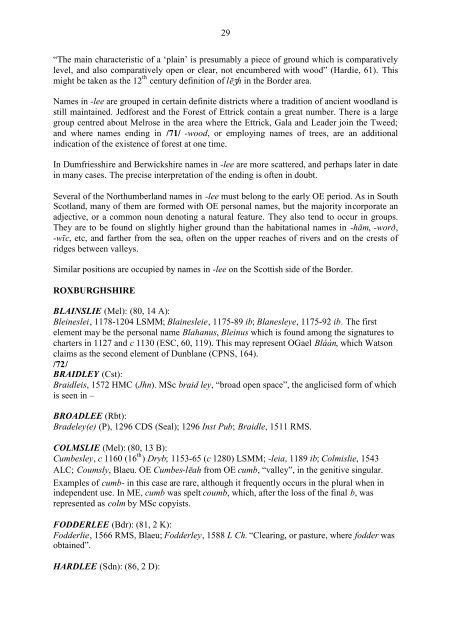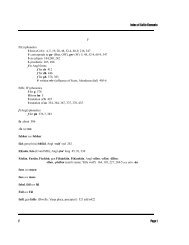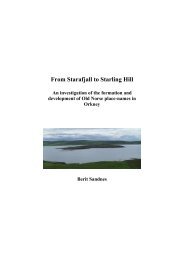May Williamson: The Non-Celtic Place-Names of the Scottish Border ...
May Williamson: The Non-Celtic Place-Names of the Scottish Border ...
May Williamson: The Non-Celtic Place-Names of the Scottish Border ...
You also want an ePaper? Increase the reach of your titles
YUMPU automatically turns print PDFs into web optimized ePapers that Google loves.
29<br />
“<strong>The</strong> main characteristic <strong>of</strong> a ‘plain’ is presumably a piece <strong>of</strong> ground which is comparatively<br />
level, and also comparatively open or clear, not encumbered with wood” (Hardie, 61). This<br />
might be taken as <strong>the</strong> 12 th century definition <strong>of</strong> lēZh in <strong>the</strong> <strong>Border</strong> area.<br />
<strong>Names</strong> in -lee are grouped in certain definite districts where a tradition <strong>of</strong> ancient woodland is<br />
still maintained. Jedforest and <strong>the</strong> Forest <strong>of</strong> Ettrick contain a great number. <strong>The</strong>re is a large<br />
group centred about Melrose in <strong>the</strong> area where <strong>the</strong> Ettrick, Gala and Leader join <strong>the</strong> Tweed;<br />
and where names ending in /71/ -wood, or employing names <strong>of</strong> trees, are an additional<br />
indication <strong>of</strong> <strong>the</strong> existence <strong>of</strong> forest at one time.<br />
In Dumfriesshire and Berwickshire names in -lee are more scattered, and perhaps later in date<br />
in many cases. <strong>The</strong> precise interpretation <strong>of</strong> <strong>the</strong> ending is <strong>of</strong>ten in doubt.<br />
Several <strong>of</strong> <strong>the</strong> Northumberland names in -lee must belong to <strong>the</strong> early OE period. As in South<br />
Scotland, many <strong>of</strong> <strong>the</strong>m are formed with OE personal names, but <strong>the</strong> majority incorporate an<br />
adjective, or a common noun denoting a natural feature. <strong>The</strong>y also tend to occur in groups.<br />
<strong>The</strong>y are to be found on slightly higher ground than <strong>the</strong> habitational names in -hām, -worð,<br />
-wīc, etc, and far<strong>the</strong>r from <strong>the</strong> sea, <strong>of</strong>ten on <strong>the</strong> upper reaches <strong>of</strong> rivers and on <strong>the</strong> crests <strong>of</strong><br />
ridges between valleys.<br />
Similar positions are occupied by names in -lee on <strong>the</strong> <strong>Scottish</strong> side <strong>of</strong> <strong>the</strong> <strong>Border</strong>.<br />
ROXBURGHSHIRE<br />
BLAINSLIE (Mel): (80, 14 A):<br />
Bleineslei, 1178-1204 LSMM; Blainesleie, 1175-89 ib; Blanesleye, 1175-92 ib. <strong>The</strong> first<br />
element may be <strong>the</strong> personal name Blahanus, Bleinus which is found among <strong>the</strong> signatures to<br />
charters in 1127 and c 1130 (ESC, 60, 119). This may represent OGael Bláán, which Watson<br />
claims as <strong>the</strong> second element <strong>of</strong> Dunblane (CPNS, 164).<br />
/72/<br />
BRAIDLEY (Cst):<br />
Braidleis, 1572 HMC (Jhn). MSc braid ley, “broad open space”, <strong>the</strong> anglicised form <strong>of</strong> which<br />
is seen in –<br />
BROADLEE (Rbt):<br />
Bradeley(e) (P), 1296 CDS (Seal); 1296 Inst Pub; Braidle, 1511 RMS.<br />
COLMSLIE (Mel): (80, 13 B):<br />
Cumbesley, c 1160 (16 th ) Dryb; 1153-65 (c 1280) LSMM; -leia, 1189 ib; Colmislie, 1543<br />
ALC; Coumsly, Blaeu. OE Cumbes-lah from OE cumb, “valley”, in <strong>the</strong> genitive singular.<br />
Examples <strong>of</strong> cumb- in this case are rare, although it frequently occurs in <strong>the</strong> plural when in<br />
independent use. In ME, cumb was spelt coumb, which, after <strong>the</strong> loss <strong>of</strong> <strong>the</strong> final b, was<br />
represented as colm by MSc copyists.<br />
FODDERLEE (Bdr): (81, 2 K):<br />
Fodderlie, 1566 RMS, Blaeu; Fodderley, 1588 L Ch. “Clearing, or pasture, where fodder was<br />
obtained”.<br />
HARDLEE (Sdn): (86, 2 D):




